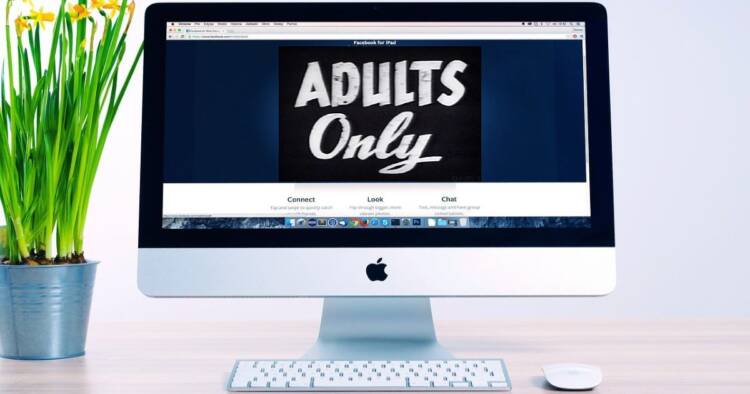How to Create a Safe-for-Work Website for Your NSFW Content
Adding a layer of indirection can help prevent deplatforming.

When you’re a sex worker, the last thing you want is to lose your platform.
Years spent building up an audience and hours poured into crafting content can be stripped away in a moment. Not to mention, a source of income.
Unfortunately, sex workers are regularly deplatformed as more commonly used platforms update their Terms of Service to exclude explicit content. With this being the reality, it can be difficult to figure out the best place to showcase NSFW content.
One option? Add a layer of indirection. Create a website that is completely safe-for-work that can drive people to other NSFW platforms that you’re active on.
“Having a safe-for-work website allows you to use that link on social media platforms, like Instagram, where you aren’t able to link to NSFW content,” says Sinnamon Love, content creator and founder of the BIPOC Adult Industry Collective.
“It becomes a way to drive traffic without having to worry about being shut down or being deplatformed.”
Must-haves for any website

What you put on your website depends on its purpose. That said, here are a few staples that most could benefit from:
Links to your NSFW content
Most importantly, your website should operate as a central hub—one place your audience can navigate to and see where the rest of your content is available online. This could include premium platforms, OnlyFans, camming sites, movies you’re featured in, or any social media pages.
“Ultimately, the goal when you are a sex worker, regardless of what type of work you’re doing, is to show people where to find you and how to give you money,” Love explains. “With the frequency of being deplatformed and also the frequency of platforms shutting down or not getting traffic and new platforms popping up—it’s really important to be able to show people how to find you.”
Every interaction someone who visits your website has to make is a potential way to lose them, so make it easy. Love recommends having an obvious navigation with clear links and featuring your most successful platforms on the homepage.
Safe-for-work images
Visuals are constantly being flagged, so be sure that any photos or videos featured on your site are safe-for-work. One suggestion from Love is to use these images as a teaser to show people what to expect on your premium platforms.
“When I’m shooting my content I’m thinking about all the different places that I’m going to use that content,” she says. “I want to make sure I’m getting full frontal images, images from behind, insertions with toys, as well as the softcore stuff… this allows me to use [content from the same shoot] in multiple places.”
Love gave the example of a photoshoot in the shower. For your website or platforms that don’t allow nudity, you may want to show images of you in a towel or where your body is abstracted behind dampened glass. On other platforms you might share a cheeky look from behind. Then save any full frontals or insertions with toys for your paid audience.
Bio information
What you share is ultimately your discretion, but let people get to know you a bit. This could be where you share the types of services you offer and rates (if applicable) or how someone can get in touch.
Newsletter signup
Curating an email list gives you power. No matter what happens on a particular platform, you’ll have a direct line to people who are actively interested in hearing from you.
“That way, you have a way of being able to communicate with your fans on a regular or semi-regular basis,” explains Love. “For example, you can send out an update and tell people ‘hey I was deplatformed, find me over here now.’”
Here are four email newsletter services that won’t ban you for adult content.
Optional extras
- Wishlist (or a link to your wishlist)
- Schedule (if you’re traveling or releasing content on particular days)
- Members-only section
- Blog
How to build it

Figuring out how to build a website for the adult industry goes back to the root of the problem: Most available platforms aren’t adult-friendly.
Sinnamon made her website with Wix back when they allowed explicit content. That has changed in recent years, but she still decides to host her website there.
“Because the website I have [on Wix] is safe-for-work, I’m fine with putting that platform there,” she says. “None of [the available website building technologies] are safe for sex workers…But if you just need to throw something up today, the easiest thing to do is to go with one of these commonly used platforms and take the risk.”
One of the best remaining platforms safe for adult content is WordPress. You can use WordPress templates to piece together your site and then work with a sex worker-friendly hosting company, like Red Umbrella Hosting and Design.
You have your website. Now what?
Make sure you’re including your website’s URL wherever possible—especially in social media bios and video descriptions so your content is less likely to be flagged. You can also add analytics to your site to see where traffic is coming from, which allows you to more effectively generate content.
“Having your own dedicated space on the internet and adding your URL to a video or to a photo has always been a really powerful way to drive traffic—no matter where people are engaging with that content,” says Love.
No matter what you decide to add to your website, try to only commit to what you can actively maintain.
“You want to think about what your day-to-day looks like and how much time you have in a week to dedicate to your website so that whatever it is you choose to do you can do it with consistency,” Love says.
“I encourage people to figure out what formula works for them.”
Image sources: Ron Frazier, Firmbee, Sinnamon Love,

















